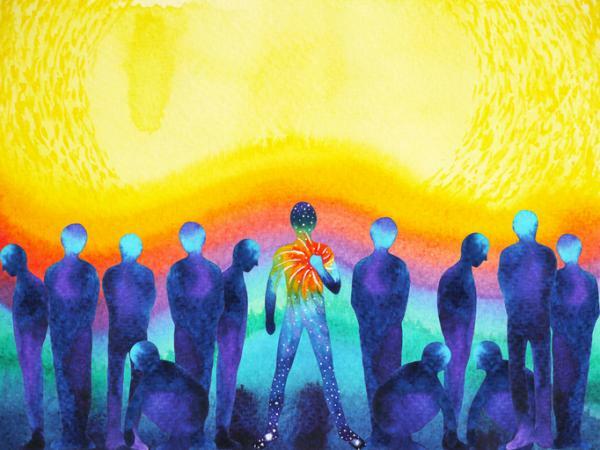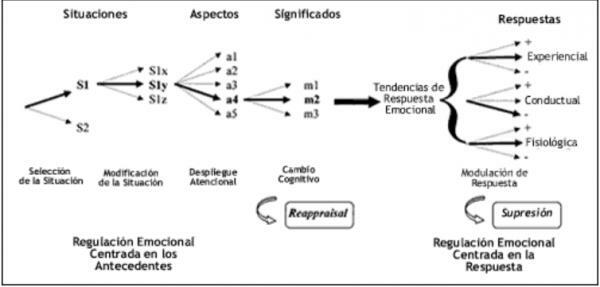
In recent years, the Emotional intelligence as a cross-cutting theme in psychology (Educational Psychology, Organizational Psychology, Psychology of Emotion ...), although the popularizations that have been made of the subject have for the moment prevented the construct from emerging in a clear. The relationship between emotional regulation and emotional intelligence seems to be quite evident.
In this Psychology-Online article, we will talk in depth about two concepts: emotional self-regulation and emotional intelligence. We will start from the exploration of different models of Emotional Intelligence to later focus on one of its components central: emotional self-regulation, and later formulating the development of an Emotional Intelligence model focused on processes, the Barret and Gross model.
Index
- Emotional Intelligence
- Traditional models on Emotional Intelligence
- Bar-On Multifactorial Model
- What is emotional self-regulation in psychology
- The relationship between emotional intelligence and emotional self-regulation
- The Gross and Barret process model
- The five elements of Gross's model
- Emotional self-regulation and emotional intelligence: conclusions
Emotional Intelligence.
Conceptual framework
Emotional Intelligence It is a field of study that emerged in the 90s as a reaction to the purely cognitive intelligences approach, adding criticism to the detractors of traditional intelligence tests.
This approach quickly became popular in the nonscientific press, not least because it broadcast a novel and engaging message: you can be successful in life without having great skills academic. Daniel Goleman's popular book (1995) quickly became a best - seller, although research on it was still in its infancy.
Mayer (2001) points out five phases so far in the development of the field of study of Emotional Intelligence that can help us understand where the concepts and skills that are currently presented together under the heading from IE:
- Intelligence and Emotions as separate fields of study (1900 - 1969): Research on intelligence develops in this period and the technology of psychological tests arises. In the field of emotion they focus on the debate between the primacy of the physiological response over emotion or vice versa. Although some authors speak about "social intelligence", the conceptions about Intelligence are still merely cognitive.
- Precursors of emotional intelligence (1970 - 1989): The field of cognition and affect examines how emotions interact with thought. A revolutionary theory from this period is Gardner's Multiple Intelligences Theory, which includes "intrapersonal" intelligence.
- Emergence of Emotional Intelligence (1990 - 1993): Mayer and Salovey publish a series of articles on emotional intelligence, including the first attempt to measure these competencies.
- Popularization and broadening of the concept (1994 - 1997): Goleman publishes his book "Emotional Intelligence" and the term IE jumps into the popular press.
- Institutionalization and research on EI (1998 - present): There are refinements in the concept of EI and new measures are introduced. The first reviews of research articles appear.
What are we talking about when we talk about Emotional Intelligence?
Emotional Intelligence is understood as a skill set involving emotions. Several authors have pointed out different definitions of Emotional Intelligence:
"It includes the areas of knowing one's own emotions, managing emotions, motivating oneself, recognizing emotions in others and managing relationships" Theory of Goleman's Emotional Intelligence (1995)
“A set of capacities, competencies and non-cognitive abilities that influence the ability own to succeed in meeting the demands and pressures of the environment "Bar - On (quoted in Mayer, 2001)
“Refers to the ability to recognize the meaning of emotions and their relationships, and to reason and solve problems based on it. It also includes using emotions to enhance cognitive activities ”Mayer et al. (2001)
In a series of studies conducted by Schutte et al. (2002) focused on finding a relationship between levels of emotional intelligence and self-esteem and positive mood, finding a positive relationship between Emotional Intelligence and both variables.
Several authors have theorized that high emotional intelligence can lead to great feelings of emotional well-being and are capable of having a better outlook on life. There is also empirical evidence that seems to show that high emotional intelligence is associated with less depression, greater optimism, and better life satisfaction. Therefore, this suggests a link between emotional intelligence and emotional well-being.

Traditional models on Emotional Intelligence.
The main models that have faced Emotional Intelligence in the 90s are those of Mayer et al. (2001) (Model of the 4 branches), the Goleman model of competences and the Multifactorial Model of Bar On.
Mayer (2001) groups these models distinguishing between mixed approaches and skills approaches:
Skills Approaches
The 4-branch model of Mayer et al. divides Emotional Intelligence into four skill areas:
- Perceive emotions: ability to perceive emotions in faces or images.
- Using emotions to facilitate thinking: ability to use emotions to enhance reasoning.
- Understanding of emotions: ability to understand emotional information about relationships, transitions from one emotion to another, and linguistic information about emotions.
- Managing emotions: ability to handle emotions and emotional relationships for personal and interpersonal growth.
These authors point out that branches 1, 3 and 4 include reasoning about emotions, while branch 2 only includes the use of emotions to enhance reasoning. Hierarchically, these 4 branches would be arranged so that "perceiving emotions" would be at the bottom, while "Emotion management" would be at the top.
Mixed Approaches
These popular approaches include personal attributes that are more commonly related to personal effectiveness and social functioning (Barret and Gross, 2001; Mayer, 2001).
Goleman's Model of Emotional Competencies
It is quite similar to the concept of empathy and includes five competencies:
- Knowing your own emotions
- The ability to control emotions
- The ability to motivate yourself
- Recognition of other people's emotions
- Managing relationships
Bar-On Multifactorial Model.
Bar On carries out a multifactorial conceptualization of emotional intelligence, made up of the following factorial components:
Formal Intrapersonal Competences
- Selfconcept: This ability refers to respecting and being aware of oneself, as one is, perceiving and accepting the good and the bad. Discover here the difference between self-esteem and self-concept.
- Emotional Self Awareness: know your own feelings to know them and know what caused them.
- Assertiveness: It is the ability to express oneself openly and defend personal rights without being aggressive or passive.
- Independence: it is the ability to control one's own actions and thinking, while still consulting others to obtain the necessary information.
- Self-update: ability to reach our potential and lead a rich and fulfilling life, committing ourselves to objectives and goals throughout life.
Interpersonal Competencies
- Empathy: The concept of empathy is the ability to recognize the emotions of others, understand them and show concern for others.
- Social responsability: It is the ability to show yourself as a constructive member of the social group, maintain social rules and be trustworthy.
- Relationships: it is the ability to establish and maintain emotional relationships characterized by giving and receiving affection, establishing friendly relationships and feeling at ease.
C.F. of Adaptability
- Reality test: This ability refers to the correspondence between what we emotionally experience and what happens objectively, it is looking for objective evidence to confirm our feelings without fantasizing or getting carried away for them.
- Flexibility: It is the ability to adjust to the changing conditions of the environment, adapting our behaviors and thoughts.
- Problem solving: the ability to identify and define problems as well as generate and implement potentially effective solutions.
This skill is composed of 4 parts:
- Be aware of the problem and feel safe and motivated in front of it
- Define and formulate the problem clearly (collect relevant information)
- Generate as many solutions as possible
- Take a solution on the solution to be used, weighing the pros and cons of each solution.
C.F. Stress Management
- Stress tolerance: This ability refers to the ability to endure stressful events and strong emotions without collapsing and coping positively with stress. This ability is based on the ability to choose various courses of action to cope with stress, be optimistic to solve a problem, and feel that one has the ability to control influence the situation.
- Pulse control: It is the ability to resist or delay an impulse, controlling emotions to achieve a later goal or of greater interest.
C.F. of Mood and Motivation
- Optimism: is to maintain a positive attitude in the face of adversity and always look on the bright side of life.
- Happiness: It is the ability to enjoy and feel satisfied with life, to enjoy oneself and others, to have fun and express positive feelings.

What is emotional self-regulation in psychology.
In all these models we can see that emotional self-regulation (understood as the ability to regulate emotional states to a point of reference) is a main element of the models. Thus, the 4-branch model of Mayer et al. places "Emotion Management" at the top of its hierarchical scale, Goleman includes it as "ability to control one's own emotions" and Bar - on includes elements of emotional self-regulation in several of his abilities, such as "Impulse Control" and "Flexibility."
In the next point we will focus on the psychological mechanism of self-regulation, offering two models of emotional self-regulation.
The relationship between emotional intelligence and emotional self-regulation.
As we have seen, the main models of Emotional Intelligence give much importance to the regulation of one's emotions. In fact, it is the cornerstone of the concept, since it is useless to recognize our own emotions if we cannot handle them adaptively.
The emotional self-regulation It would be included within what would be the general process of psychological self-regulation, which is a mechanism of the human being that allows him to maintain constant psychological balance. For this you need a control feedback system that allows you to maintain the status in relation to a control signal.
Bonano (2001) exposes a model of emotional self-regulation that focuses on the control, anticipation and exploration of emotional homeostasis. Emotional homeostasis would be conceptualized in terms of reference goals pertaining to frequencies, ideal intensities or durations of experiential, expressive, or physiological channels of responses emotional In this sense, Vallés and Vallés (2003)point out that since emotions have three levels of expression (behavioral, cognitive and psychophysiological) the regulation of emotional behavior will affect these three response systems.
Therefore, emotional self-regulation would be nothing more than a control system that would monitor that our emotional experience conforms to our reference goals.
Sequential Model of Emotional Self-Regulation
This model proposed by Bonano (2001) points out three general categories of self-regulatory activity:
- Control Regulation: it refers to automatic and instrumental behaviors aimed at the immediate regulation of emotional responses that had already been instigated. Within this category the following mechanisms are included: emotional dissociation, emotional suppression, emotional expression and laughter.
- Anticipatory Regulation: If homeostasis is satisfied at the moment, the next step is to anticipate future challenges and control needs that may arise. Within this category, the following mechanisms would be used: emotional expression, laughter, avoiding or seeking people, places or situations, acquire new skills, reassessment, write or talk about events distressing.
- Exploratory Regulation: In the event that we do not have immediate or pending needs, we can get involved in activities exploratory studies that allow us to acquire new skills or resources to maintain our homeostasis emotional. Some of these activities can be: entertainment, activities, writing about emotions
Self-regulatory Model of Emotional Experiences
The main idea from which they start Higgins, Grant and Shah (1999) is that people prefer some states more than others and that self-regulation allows the occurrence of preferred states rather than non-preferred ones. They also point out that the type of pleasure and the type of discomfort that people experience depends on what type of self-regulation is working.
These authors point out three fundamental principles involved in emotional self-regulation:
- Regulatory anticipation: Based on previous experience, people can anticipate future pleasure or discomfort. In this way, imagining a future pleasant event will produce a motivation for closeness, while imagining a future discomfort will produce a motivation for avoidance.
- Regulatory reference: faced with the same situation, a positive or negative reference point can be adopted. For example, if two people want to get married, one of them can anticipate the pleasure that would mean be married, while the other person could imagine the discomfort that would cause them not get marry. Therefore the motivation would be the same, but one of them would be moved by a positive reference point and the other by a negative point of view.
- Regulatory approach: the authors make a distinction between a promotional approach and a preventive approach. Therefore, a distinction is made between two different types of desired end states: aspirations and self-realizations (promotion) vs. responsibilities and securities (prevention).

The Gross and Barret process model.
We have already seen different models of Emotional Intelligence that have been proposed, both from popular and applied fields (Goleman and Bar-On models) and from more experimental perspectives (Mayer's Four Branch Model and Salovey).
We have also discussed the importance given to self-regulatory processes at the emotional level in these models, analyzing the models of Bonano and Higgins et al.
The Gross and Barret model: self-regulation in psychology
The models seen on emotional intelligence define it as a set of skills and personal attributes or social competencies. This would imply two basic assumptions (Barret and Gross, 2001):
- Your own emotions or those of others are seen as fixed entities on which judgments can be made correct or incorrect.
- Emotional intelligence looks like a set static skills
By contrast, the Barret and Gross process model understands emotions as an emergent and fluid phenomenon that would result from the interaction between explicit and implicit processes, so there would be no room for a correct or incorrect evaluation.
Emotional intelligence in this model would be “a set of related processes that allows the individual to satisfactorily deploy mental representations in the generation and regulation of the response emotional".
In this process scheme, there would be two aspects of great importance. On the one hand, how emotions are represented (how the person mentally represents emotions and becomes aware of them). On the other hand, how and when emotions are regulated.
Regarding the representation of emotions, we will only say here that there are three main processes involved in the generation of emotions. emotions: the availability of knowledge about emotions, the accessibility of knowledge about emotions and motivation to construct discrete emotional experiences, and finally, the location of the resources of functions such as the memory of job. These processes are of great importance for Emotional Intelligence, but we will leave them aside to focus on the other type of processes, those related to emotional self-regulation.
The Gross Model of Emotional Self-Regulation (Barret and Gross, 2001; Gross and John, 2002; Gross, 2002), on which the Emotional Intelligence process model is developed, five points are described in which the people can intervene to modify the course of the generation of emotions, that is, self-regulate emotionally. We show a general outline of the model below.

The five elements of Gross's model.
- Selection of the situation: refers to the approach or avoidance of certain people, places or objects with the aim of influencing one's own emotions. This occurs before any selection we make in which an emotional impact is present. In the diagram we see that S1 is selected instead of S2 (it is marked in bold).
- Modification of the situation: once selected, the person can be adapted to modify their emotional impact, which could also be seen as a problem-focused coping strategy (S1x, S1y, S1z).
- Attentional display: Attention can help the person choose what aspect of the situation to focus on (distracting us if the conversation bores us or try to think about something else when something is not worrying) (a1, a2, a3... they represent the different aspects of the situation to which we can attend)..
- Cognitive change: it refers to which of the possible meanings we choose from a situation. This is what could lead to "reappraisal" and would be the foundation of psychological therapies such as cognitive restructuring. Meaning is essential as it determines response trends.
- Response modulation: response modulation refers to influencing these action tendencies once they have been elicited, for example by inhibiting emotional expression. In the scheme, - and + signs are shown to represent the inhibition or excitation of these responses at different levels.
As can be seen in the model, the first four strategies would be focused on the antecedents, while the last one would be focused on the emotional response.
Much has been written about the possible consequences at various levels of emotional self-regulation. Gross (2002) notes that "reappraisal" strategies are often more effective than emotional suppression. Reappraisal reduces emotional experience as well as behavioral expression, while suppression reduces expression but fails to reduce emotional experience.
On the other hand, there is abundant literature that would indicate that suppression could be affecting physical health (depression of the immune system, increased coronary risk, cancer progression, etc.), and ultimately that the consequences of Antecedent-focused strategies (reappraisal) would be preferable in this regard to response-focused ones (Barret and Gross, 2001).

Emotional self-regulation and emotional intelligence: conclusions.
In this work we have tried offer an overview of the study of Emotional Intelligence focusing on one of its main components: emotional self-regulation. As we have been able to appreciate, there is still a multitude of models that mean that at the construct level there is no clarity of what elements make up Emotional Intelligence.
Since emotional self-regulation is one of the main mechanisms involved, We wanted to focus on it because it is a mechanism that has been widely studied over the years and for which there are quite complete explanatory models.
What alternative to classic models, of skills or competences, we wanted show the Barret and Gross process model. The implications for emotional self-regulation and emotional intelligence of this model are not only to determine the mechanisms by which emotional self-regulation occurs, but it is also the first step to elucidate what kind of mechanisms are involved in emotional intelligence and what consequences (positive and negative) they have at the cognitive, affective, social and physiological.
This article is merely informative, in Psychology-Online we do not have the power to make a diagnosis or recommend a treatment. We invite you to go to a psychologist to treat your particular case.
If you want to read more articles similar to Emotional Self-Regulation and emotional intelligence, we recommend that you enter our category of Emotions.
Bibliography
- Barret, L.F. and Gross, J.J. (2001). Emotional Intelligence. A process model of emotion representation and regulation. In T. J. Mayne and G.A. Bonano (Eds.). Emotions. Current issues and future directions. New York: The Guilford Press
- Bonano, G.A. (2001). Emotion self-regulation. In T. J. Mayne and G.A. Bonano (Eds.). Emotions. Current issues and future directions. New York: The Guilford Press
- Higgins, E.T., Grant, H. And Shah, J. (1999). Seft Regulation and quality of life: Emotional and non-emotional life experiences. In Kahneman, Diener and Schwarz (Eds.). Well-being: the foundations of hedonic psychology. New York: Russell Sage Foundation
- Goleman, D. (1996). Emotional Intelligence. Barcelona: Kairos.
- Gross, J.J. (2002). Emotion regulation: Affective, cognitive, and social consequences. Psychophysiology, 39, 281–291.
- Gross, J.J. and John, O.P. (2002). Wise emotion regulation. In L. Feldman Barret and P. Salovey (Eds.). The wisdom of feelings: Psychological processes in emotional intelligence. New York: Guilford.
- Mayer, J.D. (2001). A field guide to emotional intelligence. In Ciarrochi, J., Forgas, J.P. and Mayer, J.D. (2001). Emotional Intelligence in Everyday Life. Philadelphia: Psychology Press.
- Mayer, J. D., Salovey, P., Caruso, D. R., & Sitarenios, G. (2001). Emotional intelligence as a standard intelligence. Emotion, 1, 232-242
- Salovey, P. (2001). Applied emotional intelligence: Regulating emotions to become healthy, wealthy anda wise. In Ciarrochi, J., Forgas, J.P. and Mayer, J.D. (2001). Emotional Intelligence in Everyday Life. Philadelphia: Psychology Press.
- Schutte et al. (2002). Characteristic emotional intelligence and emotional well-being. Cognition and Emotion, 16 (6), 769-785.
- Vallés, A. and Vallés, C. (2003). Self-regulation for emotional coping. In Vallés, A. and Vallés, C. (2003). Psychopedagogy of Emotional Intelligence. Valencia: Promolibro.


